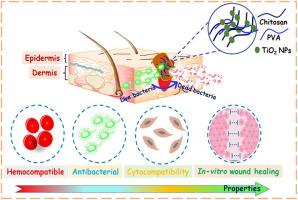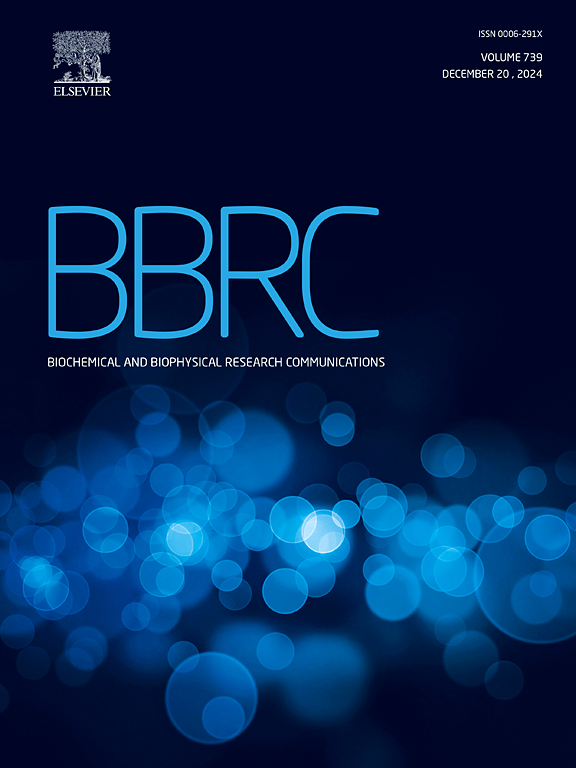壳聚糖/聚乙烯醇/TiO2复合膜体外伤口再生研究。
IF 2.2
3区 生物学
Q3 BIOCHEMISTRY & MOLECULAR BIOLOGY
Biochemical and biophysical research communications
Pub Date : 2025-01-01
DOI:10.1016/j.bbrc.2024.151129
引用次数: 0
摘要
细菌感染会显著延缓伤口的生理愈合过程,并可能对伤口区域造成进一步的损伤。在目前的工作中,我们的目标是使用铸造方法设计与壳聚糖(Chi)和聚乙烯醇(PVA)膜结合的二氧化钛纳米颗粒(TiO2 NPs),并研究其加速伤口愈合的潜力。对制备的TiO2 NPs进行了理化性质分析,TEM结果显示其平均粒径为39.6 nm。采用红外光谱(FTIR)、x射线衍射(XRD)和热重分析(TGA)对纳米复合膜进行了表征。通过扫描电镜分析,证实了纳米颗粒在Chi/PVA基体中的有效结合和均匀分散。复合膜具有优异的亲水性(64.3°),良好的膨胀和降解率,以及与天然皮肤组织相似的机械性能,确保与伤口床舒适的相互作用。较好的血液相容性,红细胞溶解率为3.52%,进一步支持了这些膜的伤口愈合性能。此外,复合膜对伤口病原菌如枯草芽孢杆菌和大肠杆菌具有良好的抗菌活性。此外,使用成纤维细胞HIH3T3细胞制备的TiO2包合膜(CPT3)在48 h的体外伤口愈合率为92.3%。结果表明,它可能是一种很有前途的伤口愈合生物材料。本文章由计算机程序翻译,如有差异,请以英文原文为准。

In-vitro investigation of chitosan/polyvinyl alcohol/TiO2 composite membranes for wound regeneration
Bacterial infections significantly delay the physiological wound healing process and can cause further damage to the wound region. In the current work, we aim to design titanium dioxide nanoparticles (TiO2 NPs) incorporated with chitosan (Chi) and poly (vinyl alcohol) (PVA) film using the casting method and to study their potential for faster wound healing. The prepared TiO2 NPs were analyzed for physicochemical properties, and TEM results showed an average particle size of 39.6 nm. The nanocomposite films were scrutinized by FTIR, XRD, and TGA analyses. The effective incorporation of the nanoparticles and their uniform dispersion within the Chi/PVA matrix was confirmed through SEM analysis. The composite films exhibited excellent hydrophilic properties (64.3°), along with favorable swelling and degradation rates, and mechanical properties similar to native skin tissue, ensuring comfortable interaction with wound beds. The better hemocompatibility, with an erythrocyte lysis percentage of 3.52 %, further supports the wound healing properties of these films. Additionally, composite films possess excellent antibacterial activity against wound pathogens such as B. subtilis and E. coli. Furthermore, an in vitro wound closure rate of 92.3 % at 48 h was observed for the TiO2 incorporated film (CPT3) using fibroblast HIH3T3 cells. The results suggest that it could be a promising biomaterial for wound healing application.
求助全文
通过发布文献求助,成功后即可免费获取论文全文。
去求助
来源期刊
CiteScore
6.10
自引率
0.00%
发文量
1400
审稿时长
14 days
期刊介绍:
Biochemical and Biophysical Research Communications is the premier international journal devoted to the very rapid dissemination of timely and significant experimental results in diverse fields of biological research. The development of the "Breakthroughs and Views" section brings the minireview format to the journal, and issues often contain collections of special interest manuscripts. BBRC is published weekly (52 issues/year).Research Areas now include: Biochemistry; biophysics; cell biology; developmental biology; immunology
; molecular biology; neurobiology; plant biology and proteomics

 求助内容:
求助内容: 应助结果提醒方式:
应助结果提醒方式:


